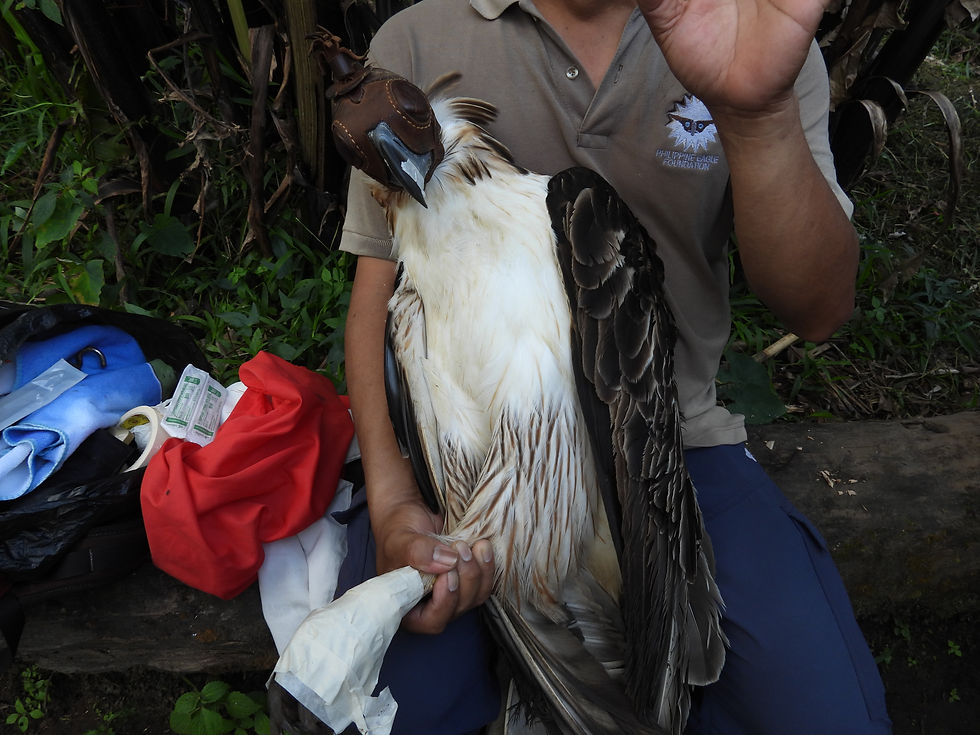Rescuing Philippine Eagle "Uswag" (formerly named “Sibulan”) of Mt Apo
- Philippine Eagle Foundation

- Aug 16, 2023
- 4 min read
Updated: Jan 31, 2024
by Julia Lynne Allong and Jayson Ibañez

On August 11, 2023, the PEF received a report from the Davao City - Public Safety and Security Command Office (PSSCO) about a wild Philippine eagle that was held captive at Sitio Cabagayan in Barangay Sibulan, Toril, Davao City. Through the help of Sibulan Punong Barangay Christine Rose Abalayan, PEF’s Director for Research and Conservation phoned Domingo Pandian, Purok Leader of Cabagayan, who had clear information about the eagle’s state and whereabouts. After getting important details about the eagle and its location, a team who led the rescue of the Philippine eagle was dispatched.

Philippine eagle "Sibulan" was kept in a makeshift enclosure as we travelled to the site.
PEF’s Senior Animal Keeper Dominic Tadena, Forester Guiller Opiso, and Biologist Julia Lynne Allong drove from the Philippine Eagle Center (PEC) at 11:30 AM to the foothills of Mt Apo in Brgy Tudaya, Digos City where the hike to the eagle’s location started. They were ably assisted by PSSCO personnel, Bantay Bukid (Forest Guards) members, Matanem Hernan Ambe, head of the Bagobo Tagabawa community at Mt Apo, and Mt Apo Park Rangers Edgardo Garcia and Rackin Indar.
The composite rescue team reached Sitio Cagaya in Sibulan at 2:40 pm. From there, the team hiked further up the mountain and reached the house of Pandian at 3:34 PM. There, they met Jay Joaquin, the guy who allegedly caught the weak eagle while hunting for frogs on the night of August 10, 2023.

Jay Joaquin (center) found the Philippine eagle while hunting for frogs. The PSSCO personnel, Bantay Bukid (two on the right) and Mt. Apo Park Rangers (two on the left), who assisted our team in reaching Sitio Cagaya.
During a short break from the hike, Joaquin narrated that he saw the eagle standing and seemingly weak while he and his friend was collecting frogs from the river. The lights from his flashlight reportedly dazed the eagle, and this gave him and his companion the opportunity to seize and pin down the eagle. He brought the eagle home and caged it inside a makeshift enclosure beneath his house. Joaquin did not give the eagle any food.
The rescue team continued trekking and reached Joaquin’s residence at 5:05 PM. The team employed standard restraint procedures to secure the eagle. Such procedure included covering the eagle’s eyes with a leather hood, wrapping its body with a standard cloth wrap, and securing the bird’s talons with packaging tape. Upon assessment of the shape and over-all appearance of its flight and tail feathers, the rescued bird was identified as a sub-adult male (about 3-4 years old). Sadly, the eagle showed signs of dehydration.
As a first aid to rehydrate the eagle, 40 mL of 0.9% NaCl solution was administered via intramuscular injection. The whole procedure lasted for almost an hour and photographs and videos of the restraint, assessment, and first-aid of the bird were taken.

40 mL of 0.9% NaCl solution was administered on Philippine eagle “Sibulan” by injection as first aid rehydration before the trip going back to Davao City.
With the aid of flashlights and guided by the Bagobo Tagabawa trailmasters, the team reached the car after almost two hours of hike. The eagle was brought straight to the clinic of our Veterinarian Consultant Dr. Bayani (Doc Bayani) Vandenbroeck for full medical screening. The team arrived at the clinic at 10:30 PM and the procedures started right away.
Standard body profiles were measured and recorded and general descriptions of the circumstances of the capture were noted by the assisting staff. The eagle weighed 4.15 kg, which is consistent with the weight range for male Philippine eagles. A re-evaluation of its tail and wing feather shapes and appearance also affirmed that the bird is still an immature bird. Blood samples were also collected for biochemical analyses and for DNA sexing.
Doc Bayani checked the bird for muscle sprains, bone fractures, and other injuries but none were seen on its body. Overall, the eagle scored “3” in body musculature, which indicates that it is in good shape. However, an x-ray detected an air gun pellet lodged inside the left nostril of the eagle. The pellet was successfully pulled out of the nostril. A crack on the upper beak of the bird was also noted. It could have been due to a strong force hitting the beak, but the team couldn’t tell what specifically caused the break.

A bullet, bruises, and signs of stress on its tail were found on PE Sibulan. According to Doc Bayani, all of which indicate several days of captivity.
There is an open wound and bruises (rope burns) on the left leg (tarsus) of the eagle. These injuries are telltales that the leg was tied and tethered either with a nylon rope or a metal chain. Doc Bayani promptly sutured the open wound and applied antiseptic to it and to the bruises post-surgery. After close inspection and critical assessment of the bird, Doc Bayani surmised that contrary to the claim by the captors (Joaquin and his companion) the bird has been recently caught, the eagle appears to have been in captivity for several days. Dirt and abrasions at the edge of the tail feathers also suggest that the bird has been tethered on the ground for quite some time. Doc Bayani recommended recuperation and rehabilitation of the eagle at the Philippine Eagle Center.
The team then transported the bird to the PEC after completing the assessments. At the PEC, the bird was fed with 300 grams of juvenile white rats as emergency food. The bird was then freed from its restraint and hood and released inside its rehabilitation cage at the facility’s raptor hospital.







Comments